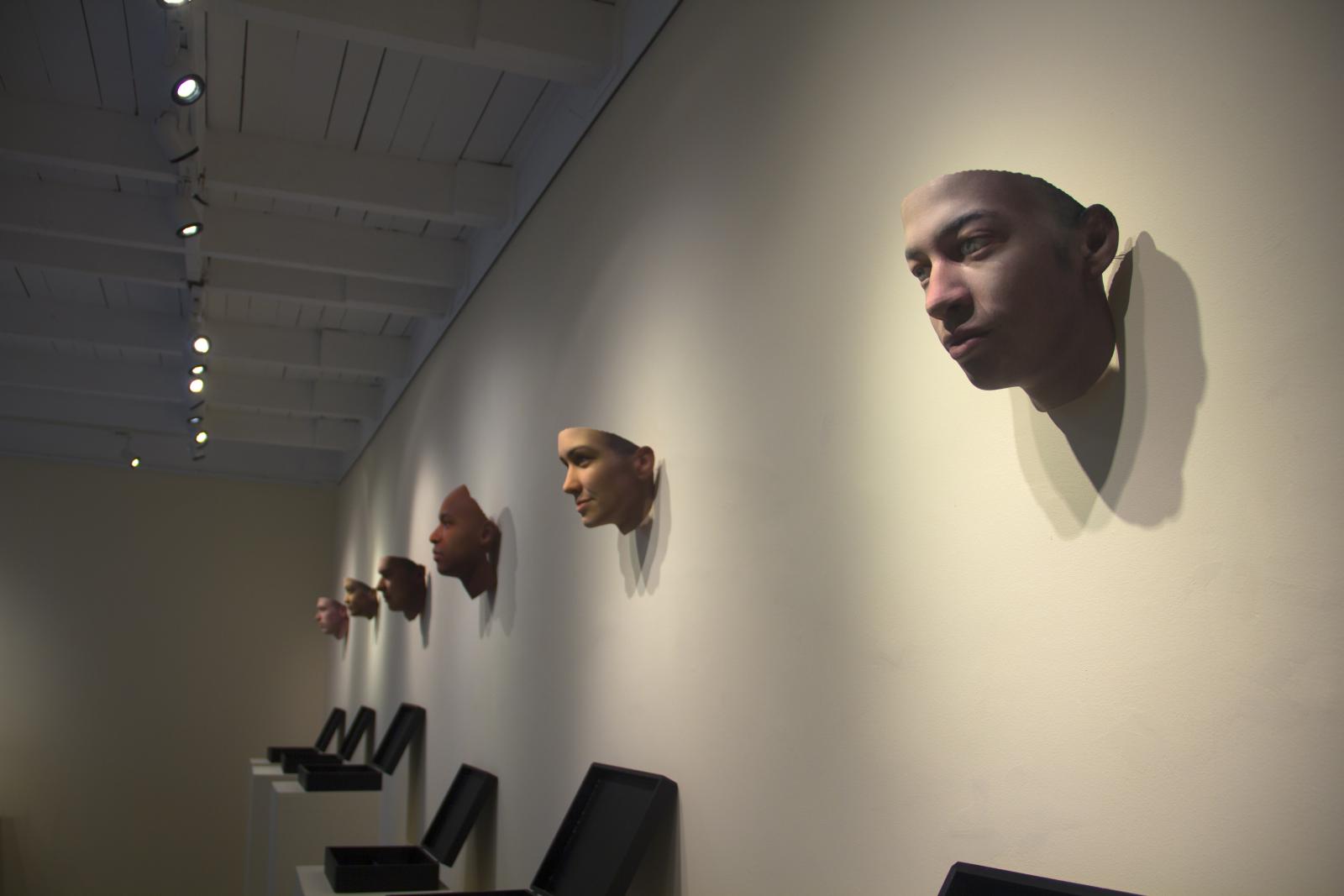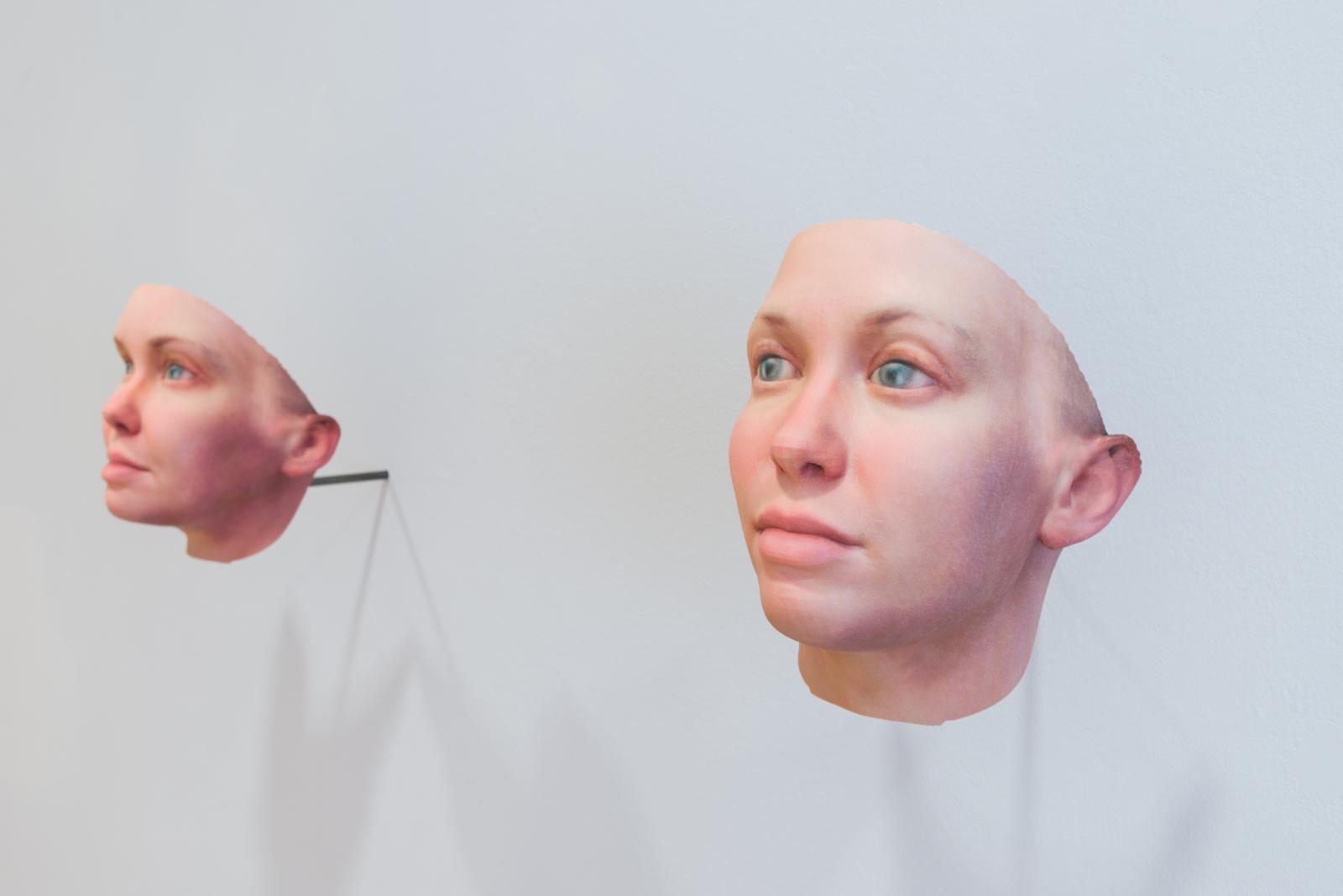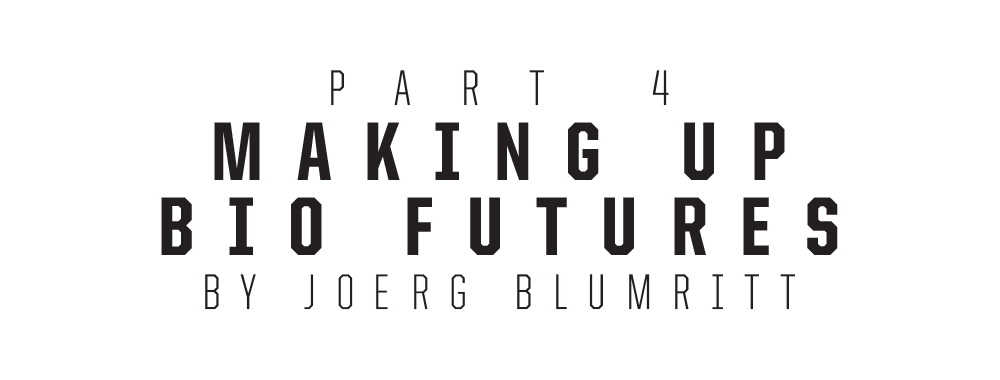DNA is called the code of life, but computational metaphors underestimate the impact of biopolitics, which reaches far beyond anything digital. Biopunk is a way to subvert biopolitics—to take the seemingly bio-determined future into our own hands and shape it according to our rules. The following text is a summary of a joint talk the three authors gave at SXSW 2017 in Austin, Texas, reflecting on the current situation, critiquing the imminent immediate future and reaching out to where biopolitical ideology might lead us when followed to its end.

Biopunk is a literary genre. The compound of a technology and the word punk, as in cyberpunk or steampunk, indicates that biotechnology is setting the stage for the narrative, providing the condition against which the human beings in the world of the story struggle. However, since there is also punk, the protagonists will repurpose the technology to outsmart their adversaries. That is the punk-ish side: Take the tech that is meant to control or oppress you, use it for your own good, and turn it against the oppressors to liberate yourself and maybe others.
Whereas in cyberpunk, artificial intelligence raises the question of what the mind is, biopunk plays with the clockwork of life to question what human nature would mean if pushed to its edge. Writers like Octavia Butler have often used biopunk to criticize the biopolitical reality of contemporary society—namely, how a closer look at gender and race reveal the seemingly biological determinants to be less "scientific" than culturally constructed.
Until recently, however, the cost of genome sequencing was just too high. Other than hacking software or soldering together electronic circuitry, hacking organisms was reserved for big research institutions or pharmaceutical companies. This has changed dramatically. Genome analysis has become a commodity. Commercial services like 23andme make the genome accessible even to people without any laboratory experience. Interpretation and classification of genomic information has become a consumer product.
So the three of us ordered our genome analytics kits: we spat into the vials, mailed our body liquids to the lab, and a few weeks later got back the long list of genetic markers together with their interpretation. Simone learned that she would not be likely to have dimples; Heather was predicted to have detached earlobes. Simone's smile easily disproves her genetic prediction, just as Heather's short hair immediately reveals earlobes firmly attached to her head. The analysis said I should be able to smell asparagus in my own urine: the reader will have to trust my word that this is true. Of the three traits chosen, two did not represent our phenotypic features. And while these were easy properties to verify, most genomic interpretation is completely inaccessible to the naked eye.
With genomic research, biological determinism has become fashionable again. It is striking, however, how few genetic mechanisms are actually understood in a functional way, i.e. which sequence of bases produces what protein and causes which effect in the body. Most research is purely probabilistic: People with a certain DNA pattern are statistically more likely to show certain characteristics such as an illness or a specific physical trait than others. Genomic research involves mostly counting frequencies in samples of a few hundred people, a few thousand at best. In its woodcut claims of panhuman generality it is hardly more sound than physiognomy, phrenology, or chirology. It may seem tempting to revive the ghosts of race, sex, and other pseudo-scientific contexts under the pretext of recent scientific advancements. But genotyping often draws its conclusions from correlations.

In early March, the Brockton, Massachusetts Police Department, along with the District Attorney of Plymouth County, held a press conference. They believed they had a break in three cold cases. Taking DNA samples found on each victim’s body, they sent the samples off to Parabon Nanolabs in Virginia for “Snapshot” DNA phenotyping, which they described in the press conference as the process of predicting physical appearance and ancestry from undisclosed DNA evidence. From this DNA evidence, Parabon Labs created a snapshot, the DA explained, that “accurately predicts genetic ancestry, eye, hair and skin color and face shape,” but he also noted that these are “scientific approximations and not exact replicas.” This did not stop the prosecutors from disseminating a mugshot-like “phenotype report” of the suspect. It included a map of the continent of Africa with parts of the west coast shaded in red. According to Parabon Labs’ report, the suspect was said to be some 28 percent European, some 57 percent West African, and some 10 percent Middle Eastern and North African. At the press conference the mayor asked for “help from the public….in particularly our rather large Cape Verdean community.” Brockton is said to be home to the largest Cape Verdean population in the US.
I remain troubled by the ways that this press conference based on “scientific approximations and not exact replicas” seemingly criminalized an entire population and, at the same time, hailed them with the responsibility to catch this killer.
When we came together to formulate this joint talk at SXSW 2017 on biopunk and acts of subverting the biotechnical gaze, I was the only one of us who hadn’t undergone genetic ancestry testing. I ordered the kit. I tried to do so as anonymously as I could. It remained on my kitchen counter, unopened, for a few months. I was never a fan of the whole process of surrendering data derived from my body to some for-profit company for them to trade, rent, or sell to others. I figured that finding my fifth cousins wasn’t worth the trade-off. But I became more curious, so I did it. I sent off the sample.
In 2015, I wrote about the use of DNA in the case of Suaad Hagi Mohamud. Mohamud was a Canadian citizen returning from a vacation in Kenya in May of 2009 when she was stopped from boarding a plane to begin her journey back to Toronto. She was told that her lips looked different than in her passport photo and that she was not the rightful holder of the Canadian passport that she held. She was detained overnight in the airport, and then moved to a detention center to be deported to Somalia. The Canadian High Commission in Kenya agreed with the Kenyan government that Suaag Hagi Mohamud was impersonating a Canadian. Back in Canada, the Minister of Foreign Affairs, when asked about Mohamud, said “there is no tangible proof that Mohamud is Canadian and that all Canadians who hold passports generally have a picture that is identical in their passport to what they claim to be.”
Mohamud petitioned the federal court in Canada to test the DNA of her Canadian-born son to prove her identity. Following the test, charges were dropped. Mohamud was released from detention and returned to Toronto in August 2009. But the case of Suaad Hagi Mohamud raised the important question of who a state can abandon at the border and by what technological means.
I’m far from a geneticist. But I’m interested in the way the cases of “Snapshot” DNA phenotyping, Suaad Hagi Mohamud, and my own ancestry testing experience, point to important questions regarding consent, the regulation of data generated from biological markers, and the uses of DNA databases for surveillance and policing.
23andme recently emailed to suggest that I upload a picture, so that my DNA relatives can get to know me better. Through their “services,” I’ve “met” some of my fourth and fifth cousins. They’ve shared details about their families—one even shared their travel plans to visit her father’s place of birth. But I haven’t even shared my real name.
I’m still troubled by my contribution to 23andme and other similar databases. In July 2015, an app was posted to GitHub that was said to use genetic data culled from 23andMe to potentially limit a user’s access to particular segments of the Internet. The app, called Genetic Access Control, proposed to make use of the then “open” nature of 23andMe’s application programming interface (API) to generate a third-party authentication application. The app would use genetic verification to restrict access to certain websites “based on traits including sex, ancestry, disease susceptibility [sic]”. Or, as the app developer put it in a list of possible uses, the app could work to create “safe spaces online where frequently attacked and trolled victim groups can congregate, such as a female-only community” and “groups defined by ethnic background, e.g. Black Panthers or NAACP members.”
I’m still not sure whether or not Genetic Access Control is stunt coding as a form of creative critique. Although Genetic Access Control’s anonymous developer noted on GitHub that “traits such as ancestry composition are speculative and statistical in nature, not precise,” this application—as a form of bio-hacking—reveals fault lines that become apparent when genetic technologies make use of DNA to reveal certain “truths” about the human body and the limits of making such sensitive data available to any interested parties.

I first met Joerg at a conference in the Hague called “Border Sessions,” where he was giving a master class, along with artist Addie Wagenknecht, on cyberpunk. Over drinks the first night we got to talking about what on earth cyberpunk could possibly mean today, and how it might be relevant. What is it about “punk” that is still useful? As an artist and biohacker I started thinking about how this related to biopunk, which in my world meant the borrowing of the DIY and anti-authoritarian aspects of the punk attitude and importing these into the practice of biology, through hands on engagement with biotechnology outside of institutional settings. Biopunk is doing biology in your kitchen and making your own equipment from scratch, much like the early garage days of personal computer development.
But it also includes critical biotechnical practice—political engagement with the materials of biology in such a way that it questions dominant discourses and oppressive frameworks. This is an artistic practice that draws on the important research of scholars like Simone. It is self-reflexive biology, where art and design have the potential to reveal alternate perspectives and enable subversive potentials. It is also a place of autonomy and self-determination. It brings these ideas to the messy wetness of biology to enact experiments from challenging authoritarian structures.
When I think about a kind of biopunk approach to life as a platform for experimentation, the practice of the artist Josiah Zayner comes to mind. He acquired notoriety for “hacking” his microbiome, replacing his own gut bacteria with that of a friend. After checking into a hotel and taking a full course of antibiotics, Josiah consumed gelatin capsules filled with the donor's fecal matter and inoculated his skin, nose and mouth with their swabs. At the end of the week, quantitative analysis seemed to show the experiment was successful.
The project was highly controversial and potentially dangerous to Josiah’s health. Scientists and the media called him irresponsible. Josiah says he is interested in personal autonomy and opening science; he thinks that institutions are slow and clunky and democratizing biology is a path to progress. From my perspective, the project shows just how limited regulation in the field of biotech is, or ever can be, when the materials and tools are so readily available through DIY techniques.
The work seems to promise a method of increasing bodily autonomy, but it raises more questions than it answers. If we are already consuming unintended hormones through sources of pollution, is increasing our consumption such a good idea? If estrogen is tied up with biopolitical control of sex and norms of gender identity, is it even more powerful to challenge these stereotypes by refusing hormones? And, of course, there is the DIY issue: is it unethical to promote an unregulated protocol which is potentially dangerous to populations who presumably are cut off from regulated supplies of hormones? Or, as Mary says, is it an act of “biotechnical civil disobedience” to subvert institutional biopower and biomedical control of our bodies while simultaneously questioning our assumptions about how hormones influence us?
My own work has also taken a political and critical approach to working with biotechnology. With Stranger Visions, in 2012, I created portraits of strangers from their abandoned DNA. I began by collecting genetic artifacts I found in public: hair, cigarette butts, chewed-up gum. I learned how to extract DNA, how to sequence it, and how to analyze it to generate a portrait of what someone might look like based on an interpretation of their DNA, utilizing scientific research ranging from the established to the speculative. I 3-D printed the portraits life size, in full color, and exhibited these alongside documentation of the artifact, where and when it was collected, and what I analyzed.

The work was meant to call attention to the vulnerability of the body to new forms of surveillance and to predict the future direction of forensic DNA phenotyping—the profiling of a person’s outward characteristics from their DNA. At the time there were clear signals this research was happening, but it hadn’t been publicly discussed.
Two years later the prediction came true with the launch of Parabon Nanolabs DNA “Snapshot”, offering genomic mugshots to police around the country. The danger of offering stereotypes based primarily on sex and ancestry predictions is that a black box algorithm in the hands of the police can become a new form of racial profiling which appears to have the authority of real genetic evidence.
Most recently, I worked with Chelsea Manning. Subject to a strict policy of visitation and representation, Chelsea’s image had been suppressed since her sentencing and gender transition in 2013. She realized that DNA could give her a kind of visibility or presence that she had been stripped of for years. Chelsea didn’t want to appear too masculine in the portraits. I realized it was a perfect opportunity to highlight the reductionism of DNA phenotyping. Instead of producing one portrait to represent her, I generated two: one that was algorithmically gender “neutral” and one parameterized “female.” I presented the two portraits side by side to focus attention on the limitations of this technique even in regards to a genetic trait considered “legible.”


Just as the libertarian fraction of the cyberpunks fantasizes about the singularity putting the mind into software, biopunk-driven positivism fantasizes about DNA code being the instructions for life itself. "We have discovered the secret of life." This was how Watson and Crick bragged about their discovery of the DNA double helix after poaching the work of their colleague Rosalind Franklin. Code is the ultimate dream.
So let's imagine what happens as this runs its course. What will evolve from biohacking, taking into consideration what we have said so far?
This biopunk future will come in three ages:
1) “Quantified bio”
23andme-like diagnostics become available at grocery rates for everybody. Just as the iPhone tracks every step I take, people will have their genomes continuously monitored, including their microbiome and all microorganisms around their house, gardens, pets and cattle. This no longer requires sequencing; the functional analysis is done with biochemical and microbiological agents directly, without much interference with the specimens. Tinder finds proper matches genomically—at least this is what it would advertise. Gated communities might require applicants to have their genomic profile within certain boundaries of 'ancestry' or other presumed properties. After genome-targeted drone killings have become a standard weapon of the U.S. military, racist terrorists also start to use targeted bio-weapons against people carrying certain genomic markers.
2) “Evolution as will and representation”
Genetic modifications are commoditized. Sanitation, hygiene, and most of medicine has moved from chemistry to biology, substituting hydrochloric acid or isopropyl alcohol with enzymes and phages. Nano-tech and biotech merge into material science on atomic levels, creating all kinds of hybrid molecules that further blur the boundary between organic and inorganic chemistry. Manufacturing and processing becomes more a process of self-assembling things instead of printing them. The climate crisis is resolved by means of airborne microbes turning CO2 into chalk and getting raw materials in abundance by organisms agglomerating rare elements. Mars terraforming has made great progress, and the Martian atmosphere has already doubled in density, with most of the additional gas composed of oxygen and nitrogen. After some time most organisms on earth are 'synthetica', finally rendering the tree-like models of Linnaean genetic ancestry obsolete. In widespread genomic punishment and corrections, deviant behavior is dealt with by infusing gene-alterations into people's bodies that might change them, but that also might immobilize them physically or mentally or just cause pain.
3) “Siphonophora humanity”
Our modified bodies are enhanced with all kinds of additional bio-receptors. These work similarly to taste buds in their method of gathering information about our environment and people within smelling distance while we pass by, without any need of cognitive processing, will feed directly into our metabolism. Communication shifts from electronic signals to pheromones—first through organizing local communities to cooperate like ants in their hill or bees in their hive—not mindlessly, just synchronized and similar-minded.
Humanity thus grows into a single organism, until the Leviathan finally rises.
• • •
JOERG BLUMTRITT (*1970) is data scientist and blogger, who co-founded the companies Datarella based in Munich, Germany, and Baltic Data Science in Gdansk, Poland.
SIMONE BROWNE is the author of Dark Matters: On the Surveillance of Blackness. She teaches Black Studies at The University of Texas at Austin.
HEATHER DEWEY-HAGBORG is a transdisciplinary artist and educator who is interested in art as research and critical practice.
